The Yucca plant care for this versatile indoor and outdoor plant is flexible, easy to care for, and easy to maintain – and is considered one of the top air-cleaning indoor plants is just another benefit.
The yucca plant is a drought-tolerant evergreen native to the hot, dry areas of the Americas and the Caribbean.
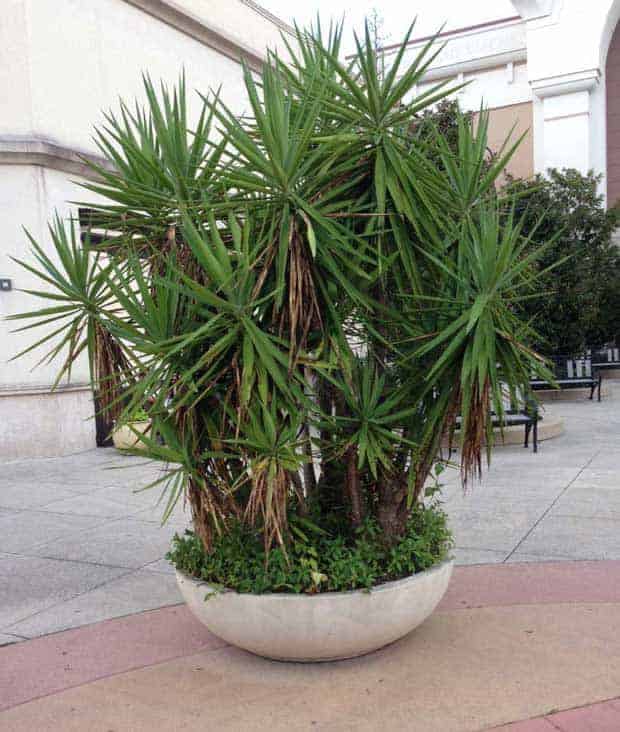
Lately, these unusual plants have become very popular as garden additions in the northern parts of the US, Canada, and the United Kingdom.
With 40 plus species and two dozen subspecies, the interesting and useful yucca plant comes in a wide variety of sizes, appearances, and shapes that have adapted to an impressive range of climates.
When first encountering yucca plants, many quickly see their relation to the Agave family (Agavoideae) to which they belong. New Mexico adopted the “yucca flower” as its state flower on March 14, 1927.
In one iteration or another, these plants can grow successfully in desert, mountain, coastal and prairie settings. When small, they can grow as houseplants.
In this article, we will explore the many different types of yucca plants and share advice on choosing and caring for just the right specimen for your home, yard, or garden.
Yucca Tree Quick Care Tips
- Botanical Name: Yucca elephantipes
- Common Name(s): Indoor yucca tree, spineless yucca, giant yucca
- Synonyms: Yucca guatemalensis, Yucca gigantea
- Family & Origin: Agavoideae family, native to America and Caribbean
- Growability: Easy to grow
- Grow Zone: USDA zone 3-10
- Size: Grows up to 30′ feet tall, but typically kept smaller indoors
- Flowering: Produces white flowers in the summer
- Light: Prefers bright, indirect light but can tolerate some direct sunlight
- Humidity: Tolerates low humidity levels
- Temperature: Thrives in temperatures between 60-80°F
- Soil: Well-draining soil, can tolerate slightly acidic to slightly alkaline soil
- Water: Allow soil to dry out between waterings, do not overwater
- Fertilizer: Fertilize once a month during growing season with a balanced fertilizer
- Pests & Diseases: Susceptible to spider mites and mealybugs, root rot can occur if overwatered
- Propagation: Propagated through stem cuttings or by removing offsets from the base of the plant
- Plant Uses: Used as a decorative indoor plant, can also be used in outdoor landscaping in warmer climates.
In this guide, we introduce you to some of the most popular yucca plant varieties and discuss the care of yucca plants indoors and outdoors.
So, what is a yucca plant? Read on to learn more.
- Yucca Tree Quick Care Tips
- Yucca Plant Quick Growing Guide:
- How Are Yucca Plants Used – Indoors and Outdoors
- Yucca Elephantipes The Spineless Indoor Yucca Houseplant
- Outdoor Yucca Plant In The Landscape
- Yucca Needs Lots of Sun & Gravelly Well-Drained Soil
- Choose The Right Yucca As A Houseplant or Container Plant
- Outdoor Yucca Tree Care – Growing And Keeping Yucca In The Landscape
- Landscape Yucca Care Growing Tips
- How To Propagate Yucca: Root, Cuttings, and Seed
- Troubleshooting Yucca Problems
- Other Uses For Yucca Plants Beyond Decorative?
- Add Drama and Beauty To Your Home and Landscape
Yucca Plant Quick Growing Guide:
Family: Agavoideae
Origin: Americas and Caribbean
Common Names: Soft tip yucca, Spanish bayonet, Spanish dagger, Joshua tree, soapweed yucca, banana yucca, Adam’s needle, Needle-Palm, Spoonleaf yucca, Mojave Yucca, Dragon Yucca, Don Quixote’s lances
Uses: Indoors as a houseplant in areas with bright light. In the landscape garden, potted in containers or directly planted in the ground.
Height: 24″ inches to 30′ feet high
USDA Hardiness Zones: Selected varieties grow from USDA zone 3 – 10
Flowers: White or cream with a soap-like fragrance
Foliage: stiff, erect, sword-like evergreen rosettes
Yucca Plant Care Requirements: indoors bright light. Outdoors bright light to full sun. Can handle poor and dry soils and conditions. Yucca plants need good, well-drained soil inside or outside. Do not allow plants to sit in water.
When caring for yucca cane plants, wear Personal Protective Equipment such as protective eyewear or goggles, gloves, and long sleeve shirt.
Miscellaneous: Approximately 40-50 species and hybrids
How Are Yucca Plants Used – Indoors and Outdoors
The Yucca plant, depending on the variety, grows outdoors in the landscape in a multitude of USDA hardiness zones, from zone 3 through 10.
However, several Yucca species – primarily Yucca elephantipes, does very well as indoor houseplant.

Yucca Elephantipes The Spineless Indoor Yucca Houseplant
Spineless yucca elephantipes is one of those indoor tropicals that prefers high light. The plant will “live” in low light, but you’ll need to make sure you apply proper watering and maintenance techniques.
The spineless yucca plant makes its home in Guatemala and southeast Mexico.
You may interpret from the southern Mexican home that the yucca plant prefers the sunshine making a south-facing window a perfect setting.
But the Yucca will do well in an east or west-facing window too. In its native environment, spineless yucca eventually matures at 30 feet tall.
Yucca Plants Indoors – Bush Or Cane
You’ll find the Yucca plant typically grown as a low-maintenance houseplant, either it’s a bush form or with multiple canes as a tree.
Bush forms are produced from tips with three plants per pot. Multiple canes (usually 3 or 4) of various staggered heights are combined and potted together in a container to create a full vertical plant for indoor use.
You’ll find with most Yucca production that plants are grown in 10″, 14″ and 17-inch pots, with plants commonly running from 36″ inches to 8′ feet in height.
Seldom do you find plants in containers larger than 17-inch pots. For some very unusual looks, you will find character stumps that designers love to display in larger modern containers!
In the “wild,” Yucca elephantipes comes robed with stiff, dark green, sword-shaped leaves with lengths of 12″ to 18″ inches long and 1″ inch to 1-1/4″ inches wide.
Indoors, the foliage may have a light or pale green color.
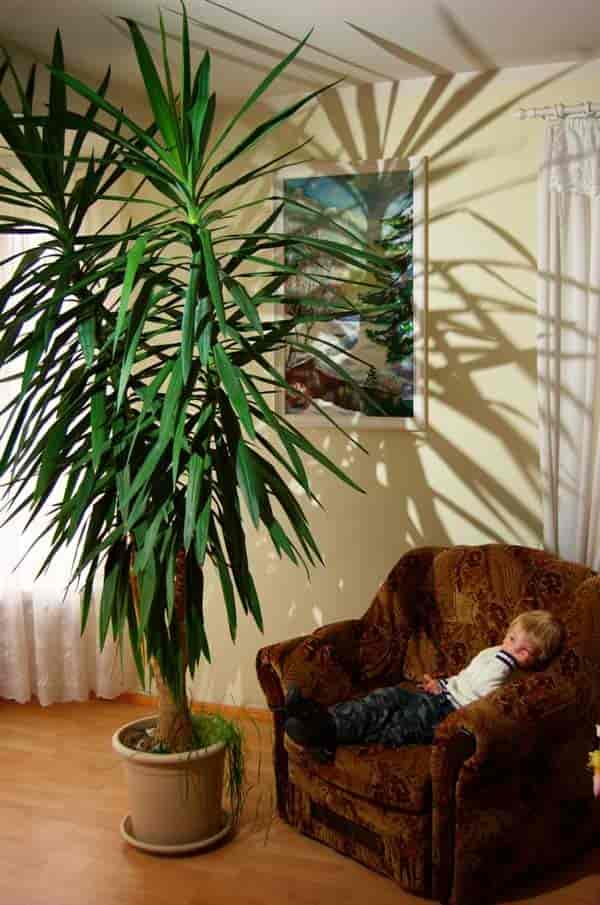
Yucca Handles Temperature Swings
Many indoor tropical houseplants DO NOT handle significant temperature changes, although they will still work at cleaning the air.
One of Yucca’s best features is its ability to handle variable temperature ranges.
With good air movement or circulation, these plants can take temperatures in the 90s to a low in the upper 30s.
This makes the spineless yucca plant an excellent choice for areas with a variety of temperature ranges, such as a lobby or home entry.
It is also a good selection for plant groupings with cactus or when you want to achieve a Southwestern look.
The spineless yucca plant probably finds more use when designing around a desert-type theme or southwest style outdoors to carry the look and feel inside.
In general, a Yucca plant is too big for the window. Their rosettes of leaves get too large. The ideal location is as a floor, specimen plant, or in groups with other plants.
Due to its versatility, reliability, and sturdiness, it does find its way into other indoor plant designs.
Yucca Elephantipes Care Tips As A Houseplant
When kept indoors, your indoor Yucca plant will appreciate a warm, sunny setting and relatively dry, well-draining soil.
The soil does not need to be rich, and in fact, a high percentage of sand or pebbles is preferable. One good combination consists of three parts peat or coco-coir and one part sand.
I’ve read that it is recommended with Yucca indoors to “water lightly by sprinkling the surface of the soil with water occasionally.” Provide a top dressing of pebbles to prevent losing this moisture into the air.
This will help your plant make the best use of its small rations of water. However, I prefer a more thorough watering or, where possible, use sub-irrigation planters. More below.
Dust the leaves from time to time by wiping the leaves clean gently with a damp cloth. Remember to wear gloves!

Trim away the occasional dead spear, cane, or flower. If you notice your yucca plant has lots of yellow, withered, or dead growth, it is probably thirsty.
You can give your indoor yucca a very diluted feeding of a balanced liquid water-soluble food in the springtime and once during the summer.
Some homeowners like to move smaller Yucca outdoors as appropriate during warm, sunny weather. I disagree. Keep your yucca plant indoors all year round.
Even with the best of intentions, moving plants indoors and outdoors can cause sunburn and acclimation issues and bring plant pests indoors as plants move back inside.
The “How To” of Watering Yucca Plants Indoors
In bright or high light settings, allow the top 1/4 or 1/3 of the soil to dry out before watering well. In low-light settings indoors, let 3/4 of the soil dry down between waterings.
I recommend using sub-irrigation or self-watering planters like this to water houseplants if possible.
When you water, DO NOT allow the yucca plant to sit in a puddle or saucer of water (like the image below) that can accumulate in the bottom of the container. Always use a pot with a drainage hole. In low-light areas, this extra water may encourage the rotting of the roots.
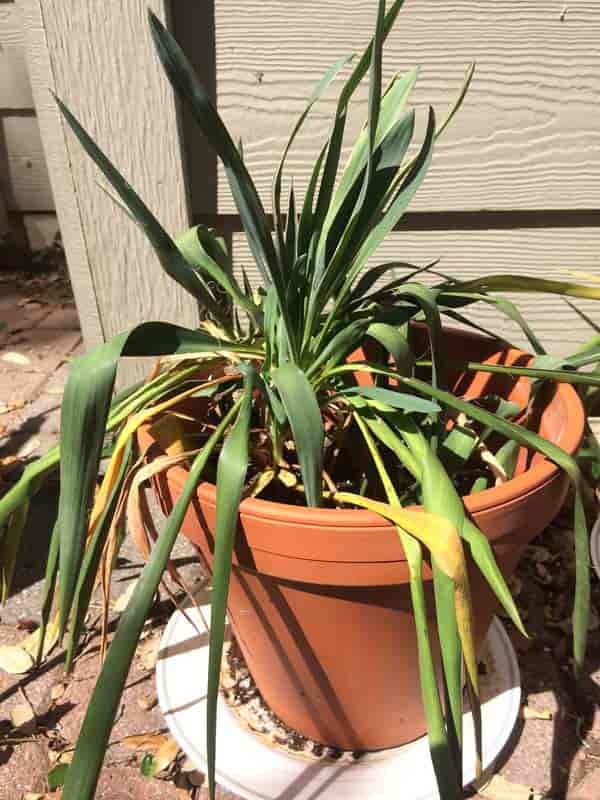
Signs of Overwatering Yucca Plants
Overwatering results in yucca plants indoors displaying foliage collapse or cane rotting, especially at the soil line.
Spineless yucca is very similar in growth and care to Dracaenas, follow the same watering practices. Water thoroughly and drain off all excess water.
Pest On Yucca Plants Indoors
Another plus for yucca plants! It’s relatively free from pest and insect problems. This is one plant spider mites don’t like.
Occasionally you may find scale or white fuzzy bugs (aka mealybugs), but generally, the plants are pest free.
When you detect insects, spray with an approved insecticide like Neem Oil, available at Amazon.
When buying a yucca plant, look for well-rooted plants with no “cane wobble,” and remember, DO NOT overwater this plant or allow it to sit in water.
More on controlling pests: Learn how to naturally get rid of spider mites on indoor plants.
Outdoor Yucca Plant In The Landscape
When it comes to choosing yucca plants for your garden or landscape, there is no shortage of options.
You may find the selection confusing as many varieties come with multiple (and sometimes shared) common names. In fact, some types look so similar it is nearly impossible to tell them apart.
Yuccas make excellent additions to the landscape, and they can also grow as container plants and houseplants when small.
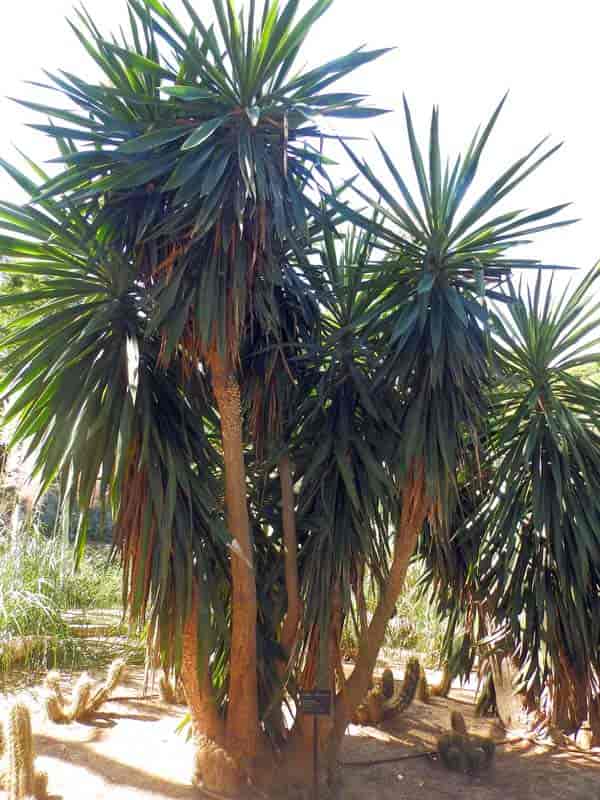
The key to success comes from choosing the right type of plant and selecting its location very carefully. In addition to determining a location most hospitable to the plant, you must also keep your safety in mind.
Most yucca plants come with sharp and dangerous spears. Like some people, the most dangerous types are dramatically good-looking, but you would not want to have them in your home, on your patio, or around your pool! [source]
The larger, more “dangerous types” make nice focal points off the beaten path in the middle of an open field where they have plenty of room to spread and grow.
In high-traffic areas, you are wiser to choose a smaller variety with strap-shaped or soft-tipped fronds. Even then, remember the edges of the fronds are sharp and can cut you. [source]
Related: How To Get Rid Of A Yucca Plant
Be advised even those with flexible or soft-tipped spears can still be dangerous. Even Yucca elephantipes, commonly kept as a houseplant when immature, have leaves with razor-sharp edges.
You can get a nasty cut when cleaning, pruning, or handling these plants. Always wear gloves and be careful when dealing with any variety of yucca plants.
Here are some of the most common varieties of yucca plants arranged according to size:
Smaller Yucca Species and Varieties
Yucca baccata
Banana Yucca or Datil Yucca (Yucca baccata) bears fruit shaped like a banana or an agave.
These fruits are quite delicious and easy to prepare by baking. At a mere five feet high, this is a fairly small specimen featuring spears of a bluish hue.
The flowers range from an off-white shade to a deep purple. This plant likes full sun and dry soil.
Yucca filamentosa
Also called Variegated Filamentosa Soapwort, Variegata, Adam’s Needle, or Ivory Towers. A beautiful plant boasting pale green spears with creamy white variegation. The leaves are quite fancily adorned with white, curly filaments or hairs.
The five-foot-tall plant produces pure white flowers late in the springtime. This plant is hardy from zone 5a to zone 10b. [source]
Color Guard is another variation of Yucca filamentosa, and it is similar to Yucca flaccida in that its spears are flexible.
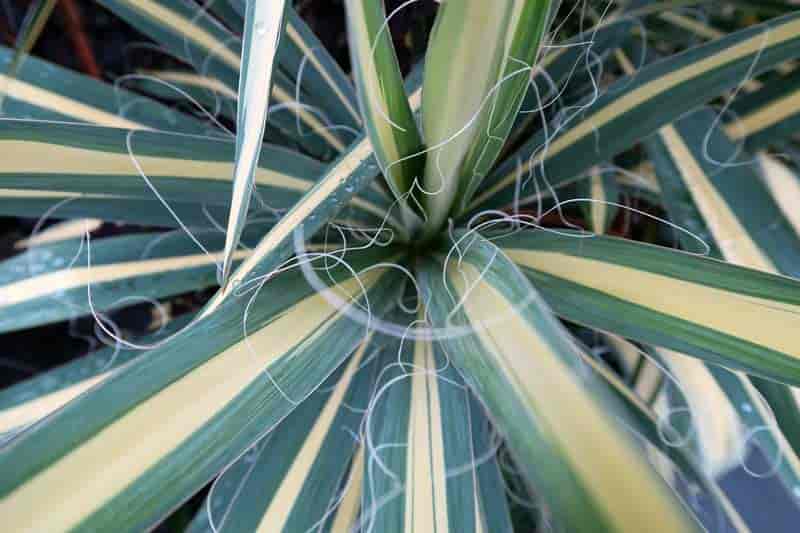
This plant hails from Japan, with truly impressive golden leaves, deep green edges, and curly white filaments.
In mid-summer, the coloration becomes more intense. The plant produces three-inch clumps of flowers on six-foot stalks, making them very attractive to hummingbirds.
Yucca gloriosa
Native to the southern United States and introduced to Britain in 1550.
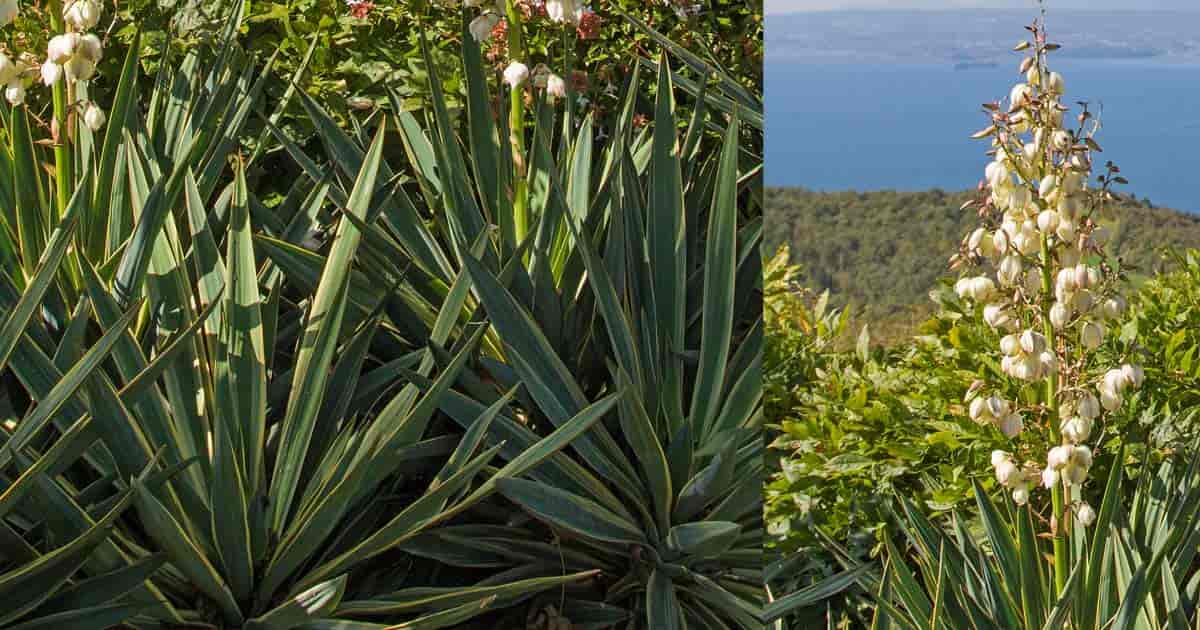
An evergreen yucca flowers in summer and early autumn. Short, thick stem, occasionally branches.
Leaves 24″ inches in length and 23″ inches wide, leathery, glaucous-green, grows in a rosette with spined leaf tips.
Impressive flowers in large panicles, creamy white flowers closely packed, hooded, and tinged with red outside.
Makes a great accent plant and is good as a container plant. Likes full sun and mild climates.
Yucca gloriosa Variegata
Also known as Variegated Mound-Lily Soapwort, this is a compact variegated form of Yucca gloriosa.
This beautiful yucca plant variety grows to about four feet high with a trunk two or three inches thick. Its rigid blue-green spears with variegated edging transition from deep gold to creamy white during the growing season.
Its flowers are large, fragrant white bells, and very attractive to hummingbirds. This hybrid is hardy from zone 7a to zone 10b.
Yucca glauca
A native to the southwestern US Yucca glauca grows in two-foot mounds producing sweet-scented flowers of a pastel green shade throughout the summer. This plant likes sandy soil and a dry climate. [source]
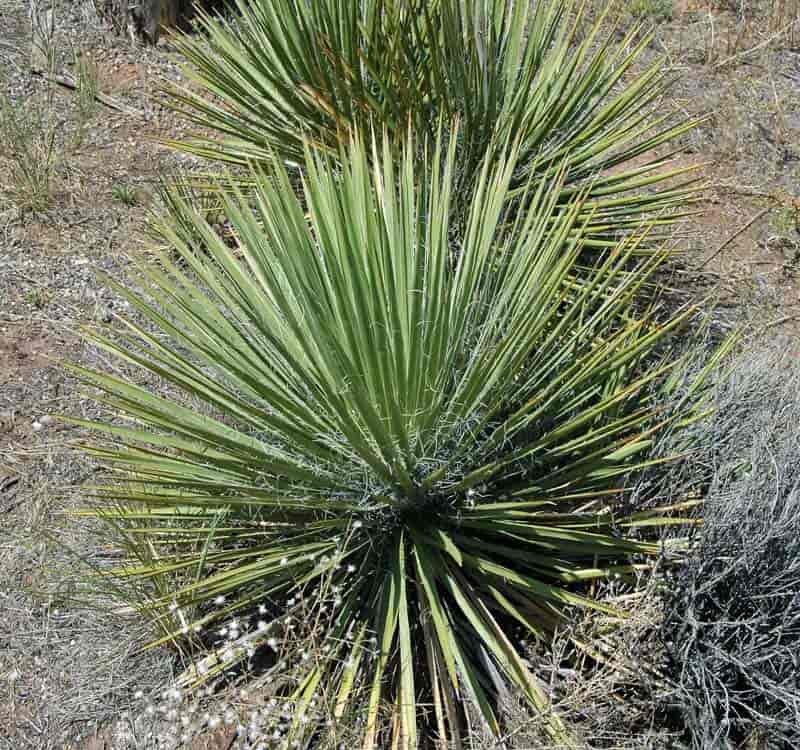
Yucca constricta
Also known as Buckley’s yucca. This native of eastern north central Texas grows abundantly in the limestone prairies. It grows as far south as the Gulf of Mexico and as far west as the Rio Grande.
This yucca plant has very narrow, sharp, relatively short spears of pale blue-green. Curly threads adorn the ends of the leaves. The shrub grows about two feet high, and the flower stalks can attain a height of about five feet. The plant is hardy in Zone 8.
Yucca smalliana
Sometimes called Adam’s needle, Needle-Plm, and Spoonleaf yucca. It is also commonly known as a Weak-leaf yucca plant because its leaves tend to bend under their own weight. This attractive shrub stands about two feet high with a flower stalk that can shoot up as high as eight feet. The flowers are large, fragrant, and white.
This variety is exceptionally cold-hardy and has become naturalized to the state of Illinois. It is native to the southeastern US and prefers sandy soil. It is hardy from zone 4a to zone 10b. [source]
A native of the Southeastern United States from Mississippi to Georgia. The large terminal rosettes foliage displays blue-green leaves with a graceful soft arch, giving it a beautiful, distinctive appearance.
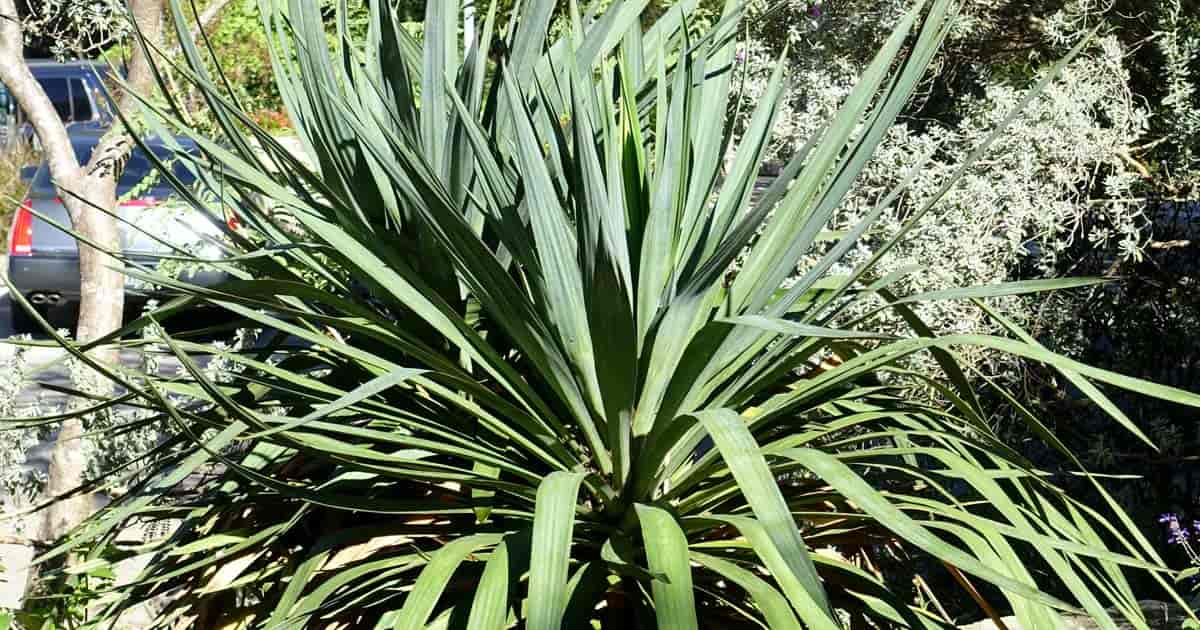
Yucca rupicola
Also called Twisted-Leaf Yucca, this is another Texas native. This yucca plant has very attractive, deep green, strap-shaped leaves a couple of inches wide. These leaves are often edged in red and adorned with curled white fibers.
The leaves grow in rosettes of about two feet high and become twisted as the plant matures. This plant does well in partial shade to full sun. It is hardy in zones 7a through 9b.
Yucca flaccida
Known also as Golden Sword is another type of flexible yucca plant. This is a smaller plant growing in clumps about 2′ feet high by 3′ feet wide. Its flexible foliage is bright yellow with green edging.
The color becomes brighter and more attractive in the fall, winter, and spring but fades in the summertime. White, bell-shaped flowers are put forth on six-foot stalks late in the spring. This plant is hardy from zone 4a to zone 10b.
Yucca arkansana
A Texas native hardy in zone 6, the plant ranges from north central to south central Texas. Yucca arkansana also shows up in parts of Arkansas and Oklahoma. It prefers a sloped setting with rocky soil, so it frequently pops up along railroad tracks.
As yuccas go, it is compact, attaining a height of about two feet. The flower stalks are usually about 3′ feet high.
The spears are bluish-green and the flowers greenish white. It does fairly well in partial shade but prefers bright sun.
Yucca pallida
Known as the Pale Yucca, this Texas native can grow in partial shade to full sun. Growing only about a foot high, it makes a good ground cover.
Its spears are pale bluish green, and its flowers pure white. The flowers appear in the middle of the summer and last for a couple of weeks. Its spears are fairly flexible. Hardy in Zones 7 through 11.
Yucca angustissima
Very similar to another variety known as Yucca harrimaniae. Both varieties are often called Toft’s yucca, Kanab yucca, or Narrowleaf Yucca. These two are so very much alike and used interchangeably.
The yucca leaf on both varieties are narrow and very rigid, thin spears adorned with short, bristly fibers along the edges of the leaves. The shrub grows to a little over a foot high, but the flower stalk can shoot up to about 6′ feet in height.
The large, pendulous flowers range from pale green to a deep cream color. Native to the southwestern US and Mexico, the plant prefers dry, sandy soil. These varieties are hardy in Zone 8b.
Large and Tree-Like Yucca Species and Varieties
Yucca schidigera or Yucca treculeana
Also called the Mojave Yucca, Spanish Dagger, or Don Quixote’s lance. This large specimen is more of a tree. Its very thick, trunk-like canes can grow up to one foot thick. The leaves of deep green with yellow tips are extremely sharp. This plant is a native of the Mojave and Sonoran deserts.

Yucca schidigera is a medicinal plant containing several physiologically active phytochemicals.
A rich source of steroidal saponins, and used commercially as a saponin source. Often added to animal feed (including pet food) to help support joint health. [source]
Yucca elephantipes or Yucca gigantea
Sometimes called Yucca Guatemalans, Yucca guatemalensis, Giant Yucca, Stick yucca, Spineless yucca, Blue Stem yucca, or Soft-Tipped Yucca.
This drought-tolerant yucca plant or tree can attain a height of thirty feet. It produces white flowers throughout the summer months.
This type of yucca looks something like a palm tree and is frequently kept as a houseplant when young. This variety is very cold sensitive, but it can be grown successfully outdoors in Zones 9 and 10.
Yucca faxoniana or Yucca carnerosana
A very tall variety that can attain a height of twelve feet. The spread of the spears can be as great as six feet. The plants are native to Texas and Mexico but can grow as far north as Denver, Colorado.
They are generally hardy in Zone 8a to Zone 11 and can do well in full sun to partial shade. These plants produce bounteous flowers from mid-spring to late spring. The flowers range in color from off-white to pale pink.
Yucca rigida
Also known as Palmilla or Blue Yucca. This plant has lovely bluish/gray spears and produces flowers of a rich, creamy yellow. This impressive plant can reach a height of fifteen feet and a width of six feet. It does well in Zones 8-10.
Yucca rostrata or Yucca thompsoniana
Also called the Thompson’s yucca, Big Bend Yucca, or Blue-Beaked Yucca.

Yucca rostrata plants can grow ten feet high and have an especially striking color, and are impressively cold hardy. In fact, it is hardy to zone 5 and grows as far north as New York State.
Yucca aloifolia
Known as the Spanish Bayonet is another huge type of Yucca. This variety has long, have, sharp green spears and large white flowers. It can grow to be eight feet high with a thick, tree-like trunk. A native of the southeastern US and hardy from Zone 8 – 11.
Related: More on Yucca aloifolia plant care

Yucca brevifolia
Sometimes called the Joshua tree yucca. This potential giant grows slowly to a height of twenty feet but can take a very long time, indeed. A native of Utah and Southern California where it provides important habitat for a wide variety of desert and prairie birds. This evergreen plant bears clusters of short, dark spears at the ends of its branches and produces white flowers. Hardy from Zone 6 to Zone 8.
Yucca filifera
Known also as the Mexican Tree Yucca or Dragon Yucca filifera. It is the largest variety and can reach a height of 30′ feet with a thick, sturdy trunk. The spears grow continuously up the trunk and form a bush at the top.
The tree may branch or simply grow straight up as a single trunk. Flower spikes are about four feet long and tend to droop rather than stand erect. The plant is native to northern Mexico and is hardy in Zones 8b or above.
Yucca Needs Lots of Sun & Gravelly Well-Drained Soil
All yuccas love the sun. While some varieties do pretty well in partial shade, they all do better with ample sun.
Yuccas generally like substantial, well-drained soil that will support the roots and the weight of the plant, along with providing good air circulation beneath the soil.
These plants do not like to be soggy. Soil that harbors moisture will cause root rot.
Choose The Right Yucca As A Houseplant or Container Plant
The Yucca plant looks great as a container plant indoors and outside. But choose wisely. You can keep a rigid speared yucca indoors, but a better choice would be a variety of soft or flexible leaved plants in the house. The potential danger of being skewered or slashed by a rigid yucca spear cannot be overstated.
There is a very good reason why these spears are used to hang meat in the smokehouse in the Appalachian mountains. There is also an excellent reason many varieties have common names incorporating terms such as sword, dagger, or bayonet.
When choosing an indoor yucca plant, look for one that will make a safe and comfortable member of your household. When looking for a patio, deck, or poolside plant, at least find one that will not get too big and create a dangerous obstacle in your path.
Video: Caring For Yucca Indoors
Choose Substantial Pots & Containers
You’ve heard the saying “Go Big Or Go Home“ – this saying applies to the containers you use to grow and display yucca trees and plants.
When choosing pots, lean toward heavy containers that provide a solid base. Otherwise, the weight of your yucca plant may cause it to topple over.
Be sure to provide your potted yucca with ample root room. Pot seedlings and very young plants in at least a gallon of soil. As the plant matures, graduate it to larger and larger containers as needed. Attempts to limit their growth with smaller pots are not successful and only make the plant unhappy.
When yucca plants reach the point you cannot comfortably move the pot anymore, it may be time to move your yucca to a large container or to a landscape setting outdoors if the plant is frost resistant.
If not, a very large yucca houseplant can make a beautiful, semi-permanent focal point in a sunroom or other open indoor space. Remember, when it gets too big, you can always harvest its useful parts and start over with a cutting, root section, offshoot, or seeds.
Outdoor Yucca Tree Care – Growing And Keeping Yucca In The Landscape
These large plants naturally like the great outdoors with plenty of room to spread and plenty of sunshine to soak up. Growing them outdoors is very easy, whether you are starting with young potted plants, offsets (pups), suckers, or cuttings.
If you plant several specimens, be sure to start off with plenty of space in between for full spread. Otherwise, you will need to do some relocating later, and that can be a painful and difficult process.
Not only is moving a mature yucca a difficult task, but it is also unlikely to be a successful one. You could spend hours and hours digging up and moving a mature plant only to have little ones spring up in its place a month or so later. Removing the entire, extensive root system is tough.
Selecting A Planting Location
When selecting your landscape setting, a slightly elevated area providing good drainage is best. Using a raised bed can be a very good idea.
Be sure the soil you choose is not excessively rich (pH 5.5-7.5) with plenty of loose material, such as vermiculite, sand, or small pebbles, to provide good drainage.
When preparing a raised bed for yucca plants, it’s a good idea to line it with about a foot of larger-sized granite rocks covered by a couple of inches of smaller pebbles to help facilitate excellent drainage.
A top dressing of granite chips is also a good idea to help prevent the plant roots from standing in water and developing rot.
Remember, the roots and the plants themselves are heavy. The soil cannot be light and airy, or it won’t provide good support for the structure of the plant. You must hit a happy medium by providing firm soil that also drains well.
If you live in an area with cold, wet winters, be prepared to protect your plants from inclement weather by providing plastic tenting in winter. If you do not wish to bother with this, choose from these varieties:
- Yucca glauca
- Yucca filamentosa
- Yucca Karlsruhensis (filamentosa × glauca)
- Yucca flaccida
- Yucca agnosticism
- Yucca Hybrid 1402 – hybrid from Denmark
- Yucca Hybrid 500 – hybrid from Denmark
All of these choices can withstand cold, wet winters without protection.
If you are unsure as to whether your yucca plant will withstand your winter, and you don’t want to bother with sheltering it, remember to take and start a cutting, offshoot, or a root segment indoors before winter begins so you can have a replacement if necessary in the springtime.
How To Plant An Outdoor Yucca
When planting, dig a hole twice as wide and deep as the root ball of the plant. Amend the native soil with sand or gravel to improve its drainage qualities. The soil you put back into the hole should be half native soil and half sand and/or gravel.
Be sure the soil is light enough to provide air circulation yet substantial enough to support the plant. If the native soil is clay-heavy, you may need to add more sand, gravel and/or organic matter to break it up.
Pad the bottom of the hole with several (2-4) inches of prepared soil. Set the plant into the hole (taking care to center and straighten it) and surround the root ball with your soil mixture.
Firm the soil down and add to it to bring the level of soil slightly higher than the surrounding soil.
Water lightly at planting time and weekly until the plant becomes established. Once established, it should be fairly drought-resistant and may not need watering except in periods of extended dry weather.
Video: How to Move Yucca
Landscape Yucca Care Growing Tips
Rugged yucca plants grow remarkably easily, and if you live in an area where they grow naturally, you may find yourself fighting them off rather than cultivating them. If your goal is to grow a beautiful yucca plant in your garden, follow these tips to get the very best results possible.
- Provide plenty of sun for robust growth and abundant flowers.
- In very dry climates, water the outdoor specimens with about one inch of water weekly.
- Remember to use well-draining, substantial soil.
- Leave plenty of space around your plant for growth and your safety.
Fertilizing is usually not necessary, but you can provide a light annual feeding if desired. To do this, sprinkle granular, balanced time-release fertilizer in a large circle around the plant in early spring. Estimate where you believe the edges of the roots are, and make your circle accordingly.
How To Prune Your Yucca
Your primary focus in caring for an established outdoor yucca plant is keeping it tidy. Check it weekly to remove dead spears, canes, and flowers. Remove debris that may collect between the spears.
In addition to just keeping your plant groomed, you may want to perform a general yucca plant pruning in the early spring to help promote or control growth. If your plant has become too tall, trim the trunk in the springtime before the growing season begins.
Tools You’ll Need For Pruning
A good pair of gloves for protecting your hands.
- Hand pruners (our Favorite Felco #2) paired with a leather holster keep pruners close at hand
- Safety glasses or goggles
- Hand Saw
- Pruning Paint
You can use the trimmed sections to propagate more yucca plants. Also, watch for offsets, which you can trim to maintain a tidy parent tree and repot to grow new plants.
Leaves at the bottom of the plant tend to turn brown and die off regularly. You can trim these or not. This is really an aesthetic choice. Some gardeners like the look of this “skirt” of leaves. Others prefer a clean, neatly trimmed appearance.
At the end of the summer, cut back dead blossoms, canes, and spent foliage. When cutting back the yucca flower stalks, leave about 3″ inches.
Here’s an interesting video about pruning a yucca plant from iCultivate. Follow this gentleman’s advice, but be sure to keep your hands and eyes protected and wear long, sturdy sleeves while doing so!
Video: How to Prune and Plant Yuccas
Video: Update on the pruned plants 6 months later
How To Propagate Yucca: Root, Cuttings, and Seed
Growing Yucca Plants From Root, Stem or Cane Cuttings
You can easily propagate yucca from root or stem cuttings. For stem cuttings, be sure the parent plant is mature, as this makes root rot less likely. Rooting is very easy. Take your cutting (the leafy top and trunk of the plant) using a sharp, clean implement.
Make a straight, clean cut, and be sure to paint the exposed stump with pruning putty to protect it and prevent infection. Although the plant will look ugly at the moment, rest assured it will go to work right away, putting out new rosettes of leaves to cover up the injury.
Video: Propagation and Transplanting Yucca
Carefully remove lower yucca plant leaves from the cutting, and allow the trunk to dry in the open air for several hours.
Even with large canes, I like to make 3-5 “cuts” length-wise on the cane with a razor knife and dust the dust the cuts with a powdered rooting hormone.
Plant the cutting a pot of properly prepared soil. Place the pot in a shady location for now, and keep the soil very slightly moist. Wait two or three weeks, and check to see if leaves or roots begin to sprout.
When this happens, wait for another 3 to 4 weeks and then begin transitioning your new plant into a sunny location.
If you prefer to do root cuttings, you can dig up a section of the plant’s rhizome and cut this up into sections of about 3″ inches each.
Bury the sections in the appropriate soil, in a sunny location, indoors or out, and keep the soil very lightly moist. You should see shoots within a month.
To propagate by division, remove offsets during regular pruning and pot them or replant them in a sunny location using an appropriate soil mixture.
You can dust the base of the pup with rooting compound if you want, but this is probably not necessary. Keep the plants very lightly moist until they set roots and establish themselves.
Sometimes potted yucca will produce suckers. You can separate the “suckers” from the parent plant and repot each yucca cane on their own in the same way you would repot offsets.
Growing Yucca Plants From Seed
It takes a long time for a yucca bush seed to germinate. In fact, it can take as long as a year. If you want to give it a try, gather your yucca seed pods after they have dried out and you hear the seeds rattling around inside.
Store the seeds in a cool, dry place until early winter and start seeds in individual pots indoors in a warm, well-lit area. Keep the soil lightly moist and wait. If you are lucky, your seed will sprout in a month.
At this point, you have a choice. When the weather becomes reliably warm, you can transition your yucca to its outdoor location. Alternatively, you can plan on keeping your baby yucca as a house plant for two or three years.
It will stay small enough to be manageable for that period. If your plant is one of the many varieties sporting sharp spears, be sure to locate it in a low-traffic area to avoid injury.
Troubleshooting Yucca Problems
Yuccas given plenty of room, plenty of sun, and dryish, gritty soil, live pretty much trouble-free, but you may encounter a few problems.
Fungus
Fungus can be a problem for outdoor yucca plants in areas with cold, wet winter weather. As mentioned, prevent this by protecting your plants from excessive moisture through the winter months by erecting a plastic tent or temporary greenhouse over them.
Snail & Slug Infestation
If you live in a damp area, slugs and snails may take up residence between your yucca’s spears. Additionally, they are very attracted to tender, young yucca plants.
Luckily, it is easy to control them by sprinkling diatomaceous earth or applying standard snail and slug bait around your plants.
Fungal Disease
If you see reddish-orange rust spots on your plant’s leaves, it is a sign that fungal infection or “yucca leaf spot” has set in. Trim away infected leaves right away to prevent the disease from spreading.
Sanitize your pruning implements after use to prevent spreading the spores to other plants. Use a fungicidal spray on your plant after trimming. Be sure to keep humidity levels moderate to avoid this problem.
- Excessively low humidity levels can cause leaves to develop brown tips.
Spider Mites
If you see gray webbing and speckled spots on Yucca spears, it is an indication of spotted mite infestation. Spray your plant thoroughly using neem oil sprays or insecticidal soap spray for plants, and prune away all dead vegetation.
Dispose of the vegetation properly by either sealing it in a plastic bag and setting it out with the trash or burning it.
Bent or Wilting Leaves
In some types of yucca, this is typical for mature leaves. If the older leaves are a bit bent, but the new leaves are not, you probably needn’t worry.
If the problem is generalized and comes on suddenly, it could be caused by the following:
- Excess watering
- Too little watering
- Excess fertilizer
- Shock following repotting
- Moving a potted plant
Review your current care routine and make adjustments as needed.
- Large numbers of yellow or brown leaves typically indicate under-watering.
- Leaves with yellow rings and/or brown tips typically indicate over-watering.
Don’t be too disappointed if you are unable to nurse an ailing yucca back to health. They are notoriously difficult to cure, but luckily they are also notoriously prolific. If you have kept some offspring, you are sure to have a replacement waiting in the wings.
Troubleshooting Readers Houseplant Yucca Q & A

Question: I’ve had a Yucca plant in my home for about five years. When I bought the plant, it had three trunks or canes in a 14-inch pot. In the past six months, one trunk has rotted away.
To “revive” my houseplant, I decided to pull out the rotted cane and repot the plant into a larger pot. The plant is now in a 20-inch pot with new soil.
I water the plant every week and use plant food every time I water. New leaves are coming out, but the ends or tips are brown. The plant sits about 8-10 feet away from my south window. What can I do to save my plant? Kathleen, Dallas, Texas.
Answer: First, thank you for the complete description of the plant problem/situation. Often the information is spotty at best and tough to reply to.
What you described covers two of the most common problems houseplant owners “face,” or I should say “cause.” The difference in your case is you waited five years or so.
All too often, plant owners assume repotting and adding plant food or All Purpose fertilizer like this will help the plant. Usually, it causes more problems.
Let’s first start with the lighting. Yucca comes from southern Mexico and craves high direct light. The first part of providing better care and maintenance begins with more light.
The plant sits too far away from a good light source; this results in weak growth, and the plant’s need for water is very low or reduced.
Most indoor yucca plants DO NOT require repotting. The excess soil only keeps excess moisture around the roots.
The large pot, watering on a weekly basis, and the plant not sitting in bright light do not allow the soil to dry out. From your description, I would assume the plant is overpotted and overwatered.
Use fertilizer on plants actively growing and not as a way to “care and fertilize the plant” back to health.
Excess salts in fertilizers will burn the unhealthy roots. The cane of your yucca probably declined slowly over the years from bad lighting and overwatering.
The brown tips on the new growth are simply “shouting” at you to check the roots for problems.
Indoor Yucca Pests – Is It Scale

At times a mature yucca sitting in the same place and pot for years may look like it is infested with plant scale bugs.
A plant owner takes care in spraying the plant with an insecticide to kill the houseplant bugs and then rinses the plant down with water to make sure no harmful chemicals hang around the house. We use Neem Oil as our natural “pesticide” solution.
Panic sets in as you wonder where this ugly “scale” came from and if it will infect the other indoor plants.
Before treating any plant for scale, it is important to know if the problem is plant scale. Scale insects should easily scratch or flick off with your fingernail.
The scale also leaves behind a sticky substance. However, yucca sometimes gets a fungus and many mistakes for scale. If fungus is the problem, remove the leaf and lower leaves to control the disease and remove the source of new fungal infections.
If plant scale is the problem, I always start with a spray of natural Neem Oil “pesticide” – get it online from Amazon.
Neem is safe and should not hurt you, the plant, or the environment. After applying or spraying the plant, rinsing off any sprayed-on material only washes off the “treatment.”
Always keep an eye out for ants on your houseplants. Ants are great farmers and love to farm scale and aphids. Keeping a watchful eye is the best way to fight problems like the scale on a yucca plant or houseplants in general.
Plant scale is a pest that spreads slowly. By monitoring your plants regularly, cleaning plant leaves, and grooming scales is not an issue with your houseplants. [source]
Other Uses For Yucca Plants Beyond Decorative?
Although most gardeners use the yucca as an attractive ornamental addition to the garden, the fact is this hardy plant is a survivalist’s dream come true. Depending upon the variety, it can be a bounteous source of food, kindling, rope, soap, and much more.
How to Make Yucca Soap (Primitive)
The non-woody parts of the plant are edible. The yucca fruit or seed pods can be baked and are quite similar to okra in appearance. When the seeds are still soft and tender, they can be removed from the pod and eaten raw.
When dry, they can be ground into flour. The flowers are very tasty (so I hear) and make a nice addition to salads, soups, stews, and stir-fry dishes.
The rhizomes are not edible and can be poisonous. Many people confuse – yucca root – with the root of the yuca plant (spelled with one “C”), also known as “cassava,” which is an important food source in Africa; however, this is an entirely different plant. The roots of the yucca plant (spelled with two “C’s”) are good for soap, not food.
Both the roots and spears of the yucca are rich in saponins or natural soap. This is why the Yucca elata is commonly known as the Soap Tree. The all-natural soap made from these parts of the tree is reputed to be an excellent shampoo and body soap.
Dried yucca spears and fibers make fire-starting easy. The dried stem of the plant is an excellent choice for starting fires using friction. When dried, all parts of the plant burn quickly and easily because of their low ignition temperature.
The spears are tough and razor-sharp. In some areas (e.g., the rural Appalachian Mountains), the green spears are used to skewer and hang fresh meat to smoke and cure. In these regions, the Yucca filamentosa is native and commonly called the “Meat Hanger.”
Yucca, An Important Host For Pollinators
Hummingbirds, butterflies, and moths flock to the rich, fragrant blossoms of this hardy, attractive plant. Specifically, the moths of the Prodoxidae family (aka Yucca Moths) maintain a significant mutuality pollination relationship with these plants.
There are several varieties of Yucca Moths. Among them are:
- Megathymus ursus – Ursine Giant Skipper
- Megathymus yuccae – Yucca Giant Skipper
- Megathymus streckeri – Strecker’s Giant Skipper
The yucca moths efficiently and industriously transfer pollen from the stamen to the stigma of the flowers and also lay their eggs inside the blossoms. When the flowers develop into seed pods, the moth eggs are inside the pods.
When the eggs hatch, the moth larvae feast on the seeds of the plant. Fortunately, the seeds are so abundant this does not hinder the reproduction of the plant. [source]
Add Drama and Beauty To Your Home and Landscape
Deer resistant, evergreen yucca plants make a truly impressive addition to almost any landscape. Because these plants can be somewhat hazardous and difficult to handle, it’s important you choose carefully. Once planted, provide proper care to enjoy the best-looking plants and the safest and most satisfying experience.
When planting outdoors, be sure to choose a variety of yucca that will remain a manageable size for your space. Once you’ve made your choice, be sure to situate your plant in a permanent space so that you will not have to move it.
Whether planted in pots, containers, or the ground, place yucca plants well away from sidewalks, poolside, doorways, gates, and other areas where adults, kids, and pets are likely to pass by frequently.
In the wild, yucca plants can live for decades and grow to enormous heights. In your home, on your patio, or in your garden, they may not become quite so immense, and they may not live as long.
Luckily, these plants are incredibly prolific and easy to grow from seed, cuttings, offsets, suckers, and root segments, so you needn’t feel sorry if your yucca plant only lasts a few years. You can simply replace it with its own offspring.
These attractive plants can add drama and beauty to your home setting, and with so many types, you can easily amass an impressive collection.
One great way to get started is to make contact with your local garden society. You can make the acquaintance of other collectors, swap starters, and enjoy an exciting gardening adventure at very little expense.
Below is a list of over 45 Yucca species and hybrids recognized by The World Checklist of Selected Plant Families at Kew.
- Yucca aloifolia also known as Yucca yucatana – aloe yucca
- Yucca angustissima – spanish bayonet
- Yucca arkansana
- Yucca baccata – Banana yucca or datil
- Yucca baileyi also known as Yucca standleyi
- Yucca brevifolia – Joshua tree
- Yucca campestris
- Yucca capensis
- Yucca carnerosana
- Yucca cernua
- Yucca coahuilensis
- Yucca constricta – Buckley’s yucca
- Yucca decipiens – Palma China
- Yucca declinata
- Yucca desmetiana
- Yucca elata – Soaptree yucca
- Yucca endlichiana
- Yucca faxoniana also known as Yucca torreyi – Torrey yucca
- Yucca filamentosa – Spoonleaf yucca, Filament yucca, or Adam’s Needle
- Yucca filifera – Palma Chuna yucca
- Yucca flaccida – Flaccid leaf yucca
- Yucca gigantea also known as Yucca elephantipes, Yucca guatemalensis – Spineless yucca
- Yucca glauca – Great Plains yucca
- Yucca gloriosa – Moundlily yucca, Adam’s needle, Spanish dagger
- Yucca grandiflora – Sahuiliqui yucca
- Yucca harrimaniae also known as Yucca nana – Harriman’s yucca
- Yucca intermedia – Intermediate yucca
- Yucca jaliscensis – Izote
- Yucca lacandonica – Tropical yucca
- Yucca linearifolia
- Yucca luminosa also known as Yucca rigida – Blue yucca
- Yucca madrensis – Soco yucca
- Yucca mixtecana
- Yucca necopina
- Yucca neomexicana – New Mexican Spanish bayonet
- Yucca pallida – Pale yucca
- Yucca periculosa – Izote
- Yucca potosina
- Yucca queretaroensis
- Yucca reverchonii
- Yucca rostrata – Beaked yucca, Big Bend yucca
- Yucca rupicola – Texas yucca, or twist-leaf yucca
- Yucca schidigera – Mojave yucca
- Yucca × schottii – Hoary yucca or mountain yucca
- Yucca sterilis
- Yucca tenuistyla
- Yucca thompsoniana – Thompson’s yucca
- Yucca treculeana – Texas bayonet, Trecul’s yucca
- Yucca utahensis
- Yucca valida
